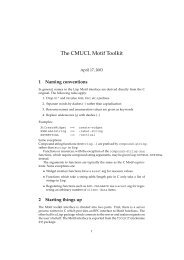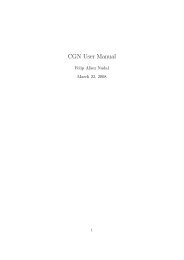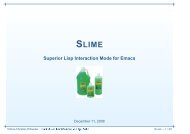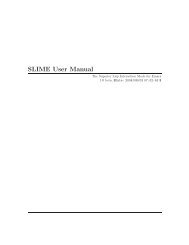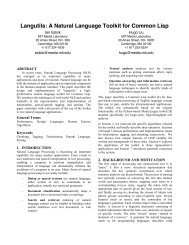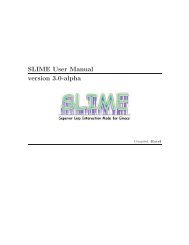Design of CMU Common Lisp.pdf - Common Lisp.net
Design of CMU Common Lisp.pdf - Common Lisp.net
Design of CMU Common Lisp.pdf - Common Lisp.net
Create successful ePaper yourself
Turn your PDF publications into a flip-book with our unique Google optimized e-Paper software.
Chapter 10<br />
Constraint propagation<br />
New lambda-var-slot:<br />
constraints: a list <strong>of</strong> all the constraints on this var for either X or Y.<br />
How to maintain consistency? Does it really matter if there are constraints with deleted vars lying around?<br />
Note that whatever mechanism we use for getting the constraints in the first place should tend to keep them up<br />
to date. Probably we would define optimizers for the interesting relations that look at their CONT’s dest and<br />
annotate it if it is an IF.<br />
But maybe it is more trouble then it is worth trying to build up the set <strong>of</strong> constraints during ICR optimize<br />
(maintaining consistency in the process). Since ICR optimize iterates a bunch <strong>of</strong> times before it converges, we<br />
would be wasting time recomputing the constraints, when nobody uses them till constraint propagation runs.<br />
It seems that the only possible win is if we re-ran constraint propagation (which we might want to do.) In<br />
that case, we wouldn’t have to recompute all the constraints from scratch. But it seems that we could do this<br />
just as well by having ICR optimize invalidate the affected parts <strong>of</strong> the constraint annotation, rather than trying<br />
to keep them up to date. This also fits better with the optional nature <strong>of</strong> constraint propagation, since we don’t<br />
want ICR optimize to commit to doing a lot <strong>of</strong> the work <strong>of</strong> constraint propagation.<br />
For example, we might have a per-block flag indicating that something happened in that block since the last<br />
time constraint propagation ran. We might have different flags to represent the distinction between discovering<br />
a new type assertion inside the block and discovering something new about an if predicate, since the latter<br />
would be cheaper to update and probably is more common.<br />
It’s fairly easy to see how we can build these sets <strong>of</strong> restrictions and propagate them using flow analysis, but<br />
actually using this information seems a bit more ad-hoc.<br />
Probably the biggest thing we do is look at all the refs. If we have proven that the value is EQ (EQL for a<br />
number) to some other leaf (constant or lambda-var), then we can substitute for that reference. In some cases,<br />
we will want to do special stuff depending on the DEST. If the dest is an IF and we proved (not null), then we<br />
can substitute T. And if the dest is some relation on the same two lambda-vars, then we want to see if we can<br />
show that relation is definitely true or false.<br />
Otherwise, we can do our best to invert the set <strong>of</strong> restrictions into a type. Since types hold only constant<br />
info, we have to ignore any constraints between two vars. We can make some use <strong>of</strong> negated type restrictions<br />
by using TYPE-DIFFERENCE to remove the type from the ref types. If our inferred type is as good as the type<br />
assertion, then the continuation’s type-check flag will be cleared.<br />
It really isn’t much <strong>of</strong> a problem that we don’t infer union types on joins, since union types are relatively<br />
easy to derive without using flow information. The normal bottom-up type inference done by ICR optimize<br />
does this for us: it annotates everything with the union <strong>of</strong> all <strong>of</strong> the things it might possibly be. Then constraint<br />
propagation subtracts out those types that can’t be in effect because <strong>of</strong> predicates or checks.<br />
This phase is optional, but is desirable if anything is more important than compilation speed. We use an<br />
algorithm similar to available expressions to propagate variable type information that has been discovered by<br />
implicit or explicit type tests, or by type inference.<br />
We must do a pre-pass which locates set closure variables, since we cannot do flow analysis on such variables.<br />
We set a flag in each set closure variable so that we can quickly tell that it is losing when we see it again.<br />
Although this may seem to be wastefully redundant with environment analysis, the overlap isn’t really that<br />
great, and the cost should be small compared to that <strong>of</strong> the flow analysis that we are preparing to do. [Or we<br />
30






